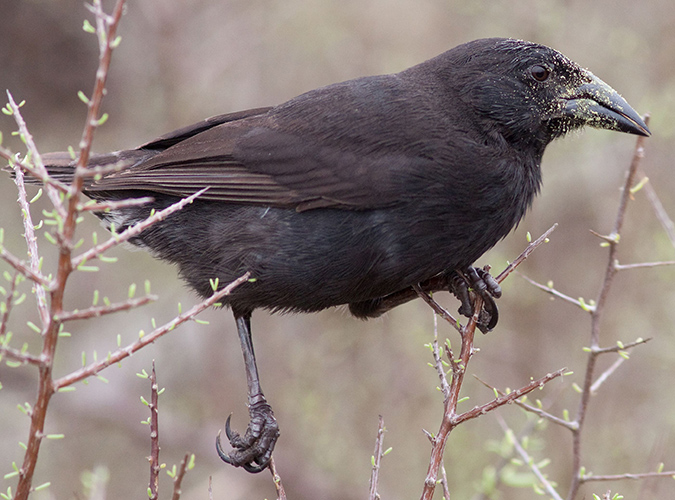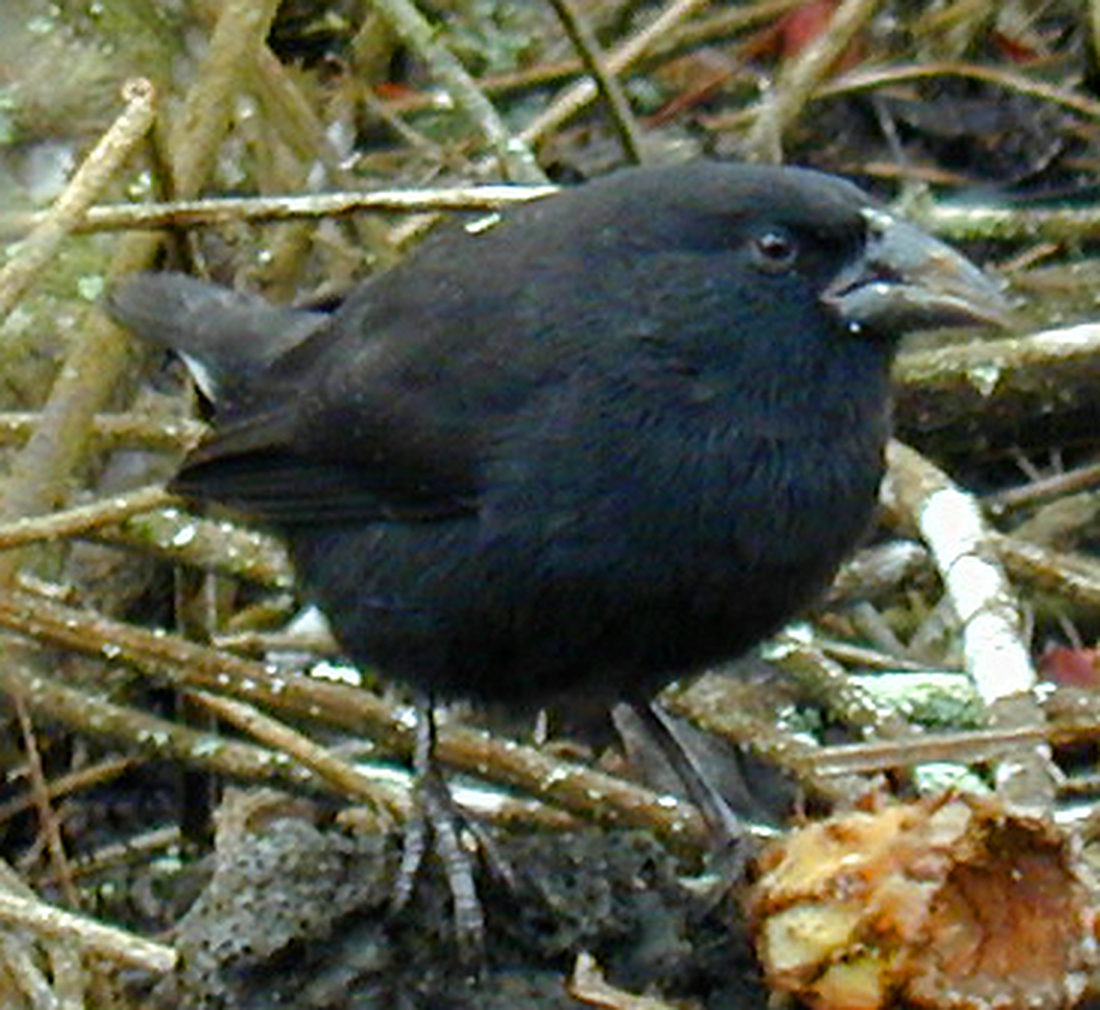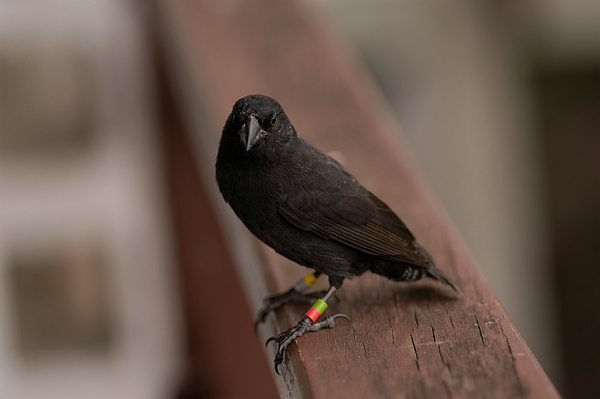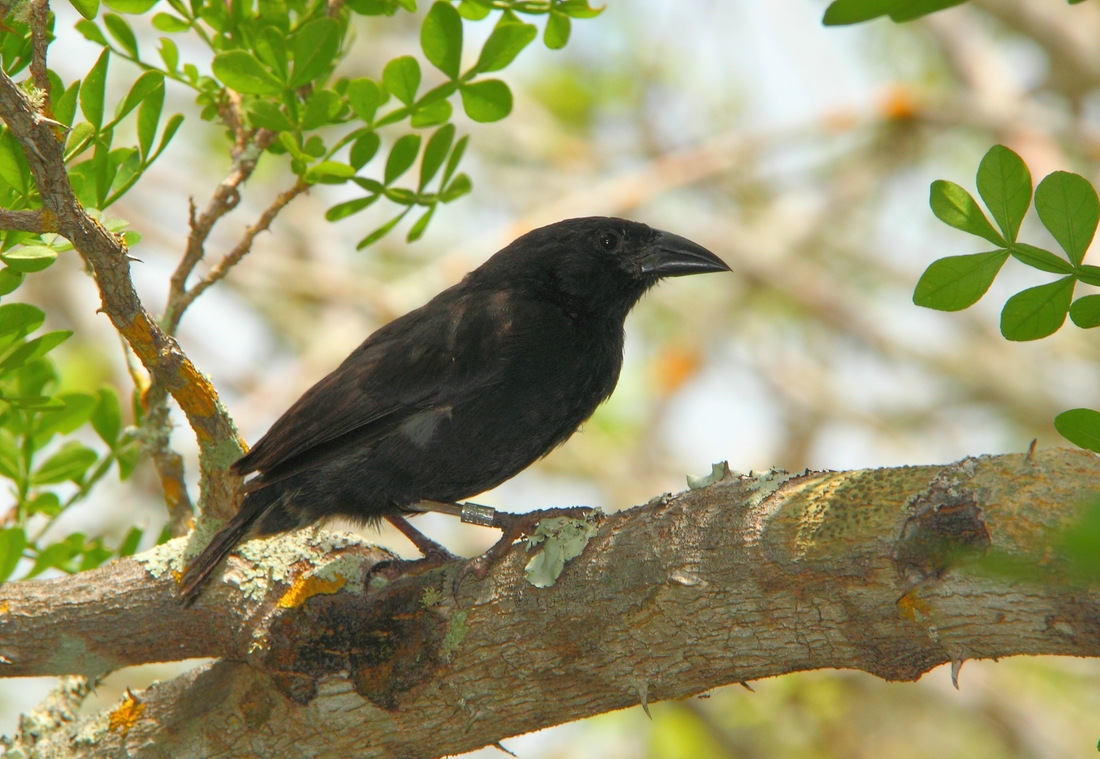Galapagos Species Database
The Galapagos Species Database shares the information about the species from our Natural History Collections.
Geospiza scandens
Pinzón Cactero Común (, Pinzón de cactus común, Common Cactus Finch







Threats The species is increasingly affected by avian pox, although no evaluation of the impact on population exists. It is also affected by the parasitic fly Philornis downsi, but little data is available.
Domain
Eukaryota
Kingdom
Animalia
Phylum
Chordata
Class
Aves
Order
Passeriformes
Family
Thraupidae
Genus
Geospiza
Species
scandens
Taxon category: Accepted
Syn.: Geospiza scandens abingdoni (P. L. Sclater & Salvin, 1870); Geospiza scandens intermedia Ridgway, 1894; Geospiza scandens rothschildi Heller & Snodgrass, 1901; Geospiza scandens scandens (Gould, 1837); Cactornis scandens Gould, 1837; Cactornis assimilis Gould, 1837; Cactornis abingdoni (Sclater & Salvin, 1870).
Taxon origin: Endemic
Preference for an altitude zone in Galapagos: Coastal zone - dry zone
Habitat preferences: Prefers dry shrub and woodlands with large Opuntia populations.
Feeding preferences: Opuntia specialist, exploits flowers, nectar, pollen, seeds, and insects and larvae from rotting pads. Also feeds on other seeds.
Trophic role: Omnivorous
Reproduction mode: Exclusively sexual
Reproductive biology: Male displays in front of a dome shape nest built in an Opuntia cactus pad. Only females incubate (three to five eggs), both feed the chicks. May start breeding slightly earlier than other finches and particularly before the onset of the rain. Always build nests between pads of Opuntia.
Map of specimen collection localities or observation records for this species in our collections database.
Distribution: Found on main islands except Fernandina and Pinzón (extinct ??).
- Wiedenfeld, D.A. (2006) Aves, the Galapagos Islands, Ecuador. Check List 2006 2(2): 1-27.
- Jiménez-Uzcátegui, G. Milstead, B., Márquez, C., Zabala, J., Buitrón, P., Llerena, A., et al. (2007) Galapagos vertebrates: endangered status and conservation actions. Galapagos Report 2006–2007. Charles Darwin Foundation, Puerto Ayora, p. 104–110.
- Harris, M.P. (1973) The Galápagos avifauna. Condor 75(3): 265-278.
- Salvin, O. (1876) On the avifauna of the Galápagos Archipelago. Transactions of the Zoological Society of London 9: 447-510.
- Sundevall, C.J. (1871) On birds from the Galápagos Islands. Proceedings of the Zoological Society of London 1871: 124-129.
- Castro, I. Phillips, A. (1996) A Guide to the Birds of the Galapagos Islands. Christopher Helm Publishers Ltd., London.
- Fessl, B. Tebbich, S. (2002) Philornis downsi - a recently discovered parasite on the Galápagos archipelago - a threat to Darwin's finches? Ibis 144: 445-451.
- Thiel, T. Whiteman, N.K., Tirapé, A., Baquero, M. I., Cedeño, V., Walsh, T., Jiménez-Uzcátegui, G. & Parker, P.G. (2005) Characterization of canary pox-like viruses infecting endemic birds in the Galapagos Islands. Journal of Wildlife Diseases 41(2): 342-353.
- Swarth, H.S. (1931) The Avifauna of the Galapagos Islands. Occ. Pap. Calif. Acad. Sci. 18: 1-299.
- Kleindorfer, S. Dudaniec, R.Y. (2006) Increasing prevalence of avian poxvirus in Darwin’s finches and its effect on male pairing success. Journal of Avian Biology 37: 69-76.
- Jiménez-Uzcátegui, G. Betancourt, F. (2008) Avifauna vs automotores. Informe Galápagos 2007-2008. FCD, PNG & INGALA. Puerto Ayora, Ecuador. p. 111–114.
- Bisconti, M. Landini, W., Bianucci, G., Cantalamessa, G., Carnevale, G. Ragaini, L. & Valleri, G. (2001) Biogeographic relationships of the Galapagos terrestrial biota: parsimony analyses of endemicity based on reptiles, land birds and Scalesia land plants. J. Biogeogr. 28: 495-510.
- Donohue, K. (2011) Darwin's Finches: Readings in the Evolution of a Scientific Paradigm University of Chicago Press, Chicago, 492 pp.
- Guerrero, A. Tye, A. (2009) Darwin's Finches as seed predators and dispersers. The Wilson Journal Of Ornithology 121 (4):752-764, 2009
- Alatalo, R. V. (1982) Bird Species Distributions in the Galapagos, Ecuador, and Other Archipelagoes: Competition Or Chance?. Ecology 63 (4): 881-887
- Helsen, P. Verdyck, P., Tye, A., Van Dongen, S. (2008) Low levels of genetic differentiation between Opuntia echios varieties on Santa Cruz (Galápagos) Springer-Verlag. 2009
- McMullen, C.K. (1987) Biologia reproductiva de las Angiospermas de las Islas Galapágos. Pg. 39 - 52. Memorias: Taller sobre investigación Botànica y manejo en galapágos.
- Dvorak, M. Fessl, B., Nemeth, E., Kleindorfer, S.M., & Tebbich, S. (2012) Distribution and abundance of Darwin ́s Finches and other land birds on Santa Cruz Island Galapagos: evidence for declining populations. Oryx 46:78-86
- Grant, P.R. Grant, B.R. (1997) Mating patterns of Darwin's Finch hybrids determined by song and morphology. Biological Journal of the Linnean Society 60:317-343.
- Boag, P.T. (1984) Growth and allometry of external morphology in Darwin's finches (Geospiza) on Isla Daphne Major, Galápagos. Journal of Zoology 204:413-441.
- Gibbs, H. Grant, P. (1987) Adult survivorship in Darwin's Ground Finch (Geospiza) populations in a variable environment. Journal of Animal Ecology 56:797-814.
- Grant, B.R. (2003) Evolution in Darwin’s Finches: a review of a study on Isla Daphne Major in the Galápagos Archipelago. Zoology 106:255-259.
- Grant, B.R. (1996) Pollen digestion by Darwin's finches and its importance for early breeding. Ecology 77:489-499.
- Grant, B.R. Grant, P.R. (1996) High survival of Darwin's finch hybrids: effects of beak morphology and diets. Ecology 77:500-509.
- Grant, B.R. Grant, P.R. (2010) Songs of Darwin’s finches diverge when a new species enters the community. Proceedings of the National Academy of Sciences 107:20156–20163.
- Stern, D. Grant, P. (1996) A phylogenetic reanalysis of allozyme variation among populations of Galápagos finches. Zoological Journal of the Linnean Society 118:119-134.
- Petren, K. Grant, B. & Grant, P. (1999) A phylogeny of Darwin's finches based on microsatellite DNA length variation. Proceedings of the Royal Society of London Series B-Biological Sciences 266:321-329.
- Petren, K. Grant, P., Grant, B. & Keller, L. (2005) Comparative landscape genetics and the adaptive radiation of Darwin’s finches: the role of peripheral isolation. Molecular Ecology 14:2943-2957.
- Zylberberg, M. Lee, K., Klasing, K. & Wikelski, M. (2012) Increasing avian pox prevalence varies by species, and with immune function, in Galápagos finches. Biological Conservation 153:72-79.
- Schluter, D. Grant, P. (1984) Ecological correlates of morphological evolution in a Darwins Finch Geospiza difficilis. Evolution 38:856-869.
- Schluter, D. (1982) Distributions of Galápagos ground finches along an altitudinal gradient: the importance of food supply. Ecology 63:1504-1517
- Grant, P.R. (1993) Hybridization of Darwin's finches on Isla Daphne Major, Galápagos. Philosophical Transactions of the Royal Society of London. Series B, Biological Sciences 340:127-139.
- Grant, P.R. Grant, B.R. (2010) Conspecific versus heterospecific gene exchange between populations of Darwin's finches. Philosophical Transactions of the Royal Society of London. Series B, Biological Sciences 365:1065-1076.
- Grant, P.R. Grant, B.R. (1997) Hybridization, sexual imprinting, and mate choice. The American Naturalist 149:1-28.
- Grant, P.R. Grant, B.R. (1994) Phenotypic and genetic effects of hybridization in Darwin's finches. Evolution 48:297-316.
- Farrington, H. Lawson, L., Clark, C. & Petren, K. (2014) The evolutionary history of Darwin's finches: speciation, gene flow, and introgression in a fragmented landscape. Evolution doi 10.1111/evo.12484.
- Grant, B.R. Grant, P.R. (1996) Cultural inheritance of song and its role in the evolution of Darwin's finches. Evolution 50:2471-2487.
- Grant, P.R. Grant, B.R. (2002) Unpredictable evolution in a 30-year study on Darwin's Finches. Science 296:707-711.
- Keller, L. Grant, P., Grant, B. & Petren, K. (2002) Environmental conditions affect the magnitude of inbreeding in survival of Darwin's finches. Evolution 56:1229-1239.
- Grant, P.R. (1983) Inheritance of size and shape in a population of Darwin's finches, Geospiza conirostris. Proceedings of the Royal Society of London Series B-Biological Sciences 220:219-236.
- Grant, B.R. Grant, P.R. (1981) Exploitation of Opuntia cactus by birds on the Galápagos. Oecologia 49:179-187.
- Millington, S.J. Grant, P.B. (1984) The breeding ecology of the cactus finch Geospiza scandens on Isla Daphne Major Galápagos Ecuador. Ardea 72:177-188.
- Millington, S.J. Grant, P.R. (1983) Feeding ecology and territoriality of the cactus finch, Geospiza scandens in Isla Daphne Major, Galapagos. Oecologia 58:76-83.
- Millington, S.J. Price, T. (1985) Song inheritance and mating patterns in Darwins Finches. The Auk 102:342-346.
- Markert, J. Grant, P., Grant, B., Keller, L., Coombs, J. & Petren, K. (2004) Neutral locus heterozygosity, inbreeding, and survival in Darwin's ground finches (Geospiza fortis and G. scandens). Heredity 92:306-315.
- Lack, D. (1945) The Galapagos Finches (Geospizinae). A Study in Variation. Occasional papers of the California Academy of Sciences 21:1-158.
- Grant, P.R. Grant, B.R. (2011) Causes of lifetime fitness of Darwin’s finches in a fluctuating environment. Proceedings of the National Academy of Sciences 108:674-679.
- Grant, P.R. Grant, B.R. (2000) Non-random fitness variation in two populations of Darwin's finches. Proceedings of the Royal Society of London Series B-Biological Sciences 267:131-138.
- Grant, P.R. Grant, B.R. (1992) Demography and the genetically effective sizes of two populations of Darwin's Finches. Ecology 73:766-784.
- Grant, P.R. Grant, B.R. (1980) Annual variation in finch numbers, foraging and food supply on Isla Daphne Major, Galápagos. Oecologia 46:55-62.
- Grant, P.R. Grant, B.R. (1976) Darwin's finches: population variation and natural selection. Proceedings of the National Academy of Sciences of the United States of America 73:257-261.
- Grant, P.R. Grant, B.R., Keller, L., Markert, L. & Petren, K. (2003) Inbreeding and interbreeding in Darwin's finches. Evolution 57:2911-2916
- Grant, P.R. Grant, B., Markert, J., Keller, L. & Petren, K. (2004) Convergent evolution of Darwin's finches caused by introgressive hybridization and selection. Evolution 58:1588-1599.
- IUCN (2015) The IUCN Red List of Threatened Species. Version 2015-4. <www.iucnredlist.org>. Downloaded on 20 November 2015.
- Lamichhaney, S. Berglund, J., Sällman Almén, M., Maqbool, K., Grabherr, M., Martinez-Barrio, A., Promerova, M., Rubin, C.J., Wang, C., Zamani, N., Grant, B.R., Grant, P.R., Webster, M.T., Andersson, L. (2015) Evolution of Darwin’s finches and their beaks revealed by genome sequencing Nature 518: 371-386. doi:10.1038/nature14181
- Remsen, J.V. Areta, J.I.Jr., Cadena, C.D., Claramunt, S., Jaramillo, A., Pacheco, J.F., Pérez-Emán, J., Robbins, M.B., Stiles, F.G., Stotz, D.F., Zimmer, K. J. (2016) A Classification of the Bird Species of South America. South American Classification Committee. American Ornithologists' Union http://www.museum.lsu.edu/~Remsen/SACCBaseline.htm
- IUCN (2017) The IUCN Red List of Threatened Species Version 2016-3. <www.iucnredlist.org>. Downloaded on 03 February 2017.
- Freile, J.F. Santander, T., Jiménez-Uzcátegui, G., Carrasco, L., Cisneros-Heredia, D., Guevara, E., Sánchez-Nivicela, M., Tinoco, B. (2019) Lista Roja de las aves del Ecuador Quito, Ecuador. 97 pp.



Feeding type: Polyphagous
Flowers and nectar of Opuntia, pollen, seeds and insects